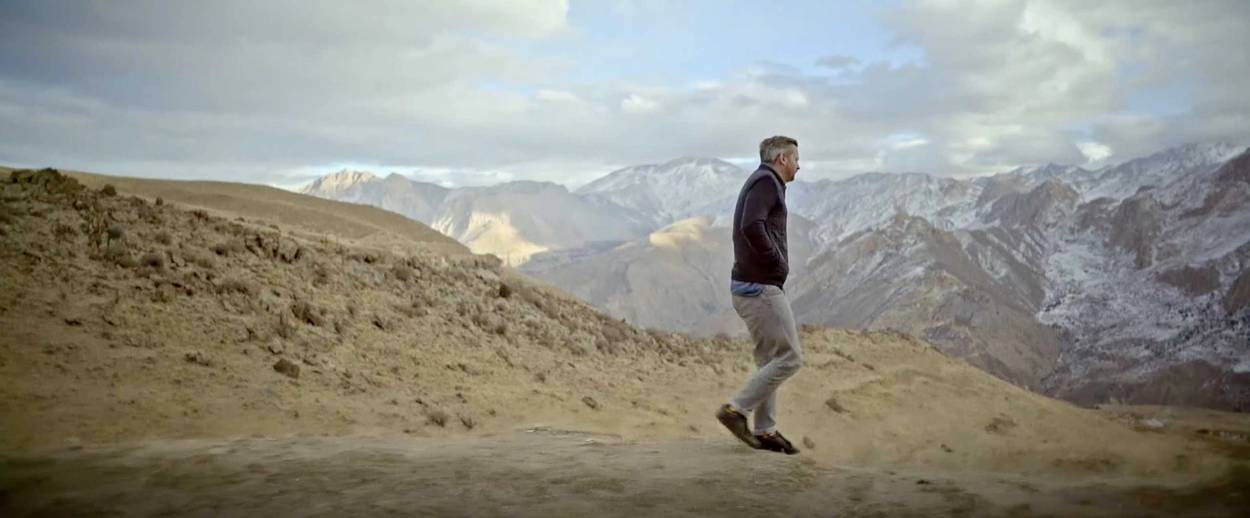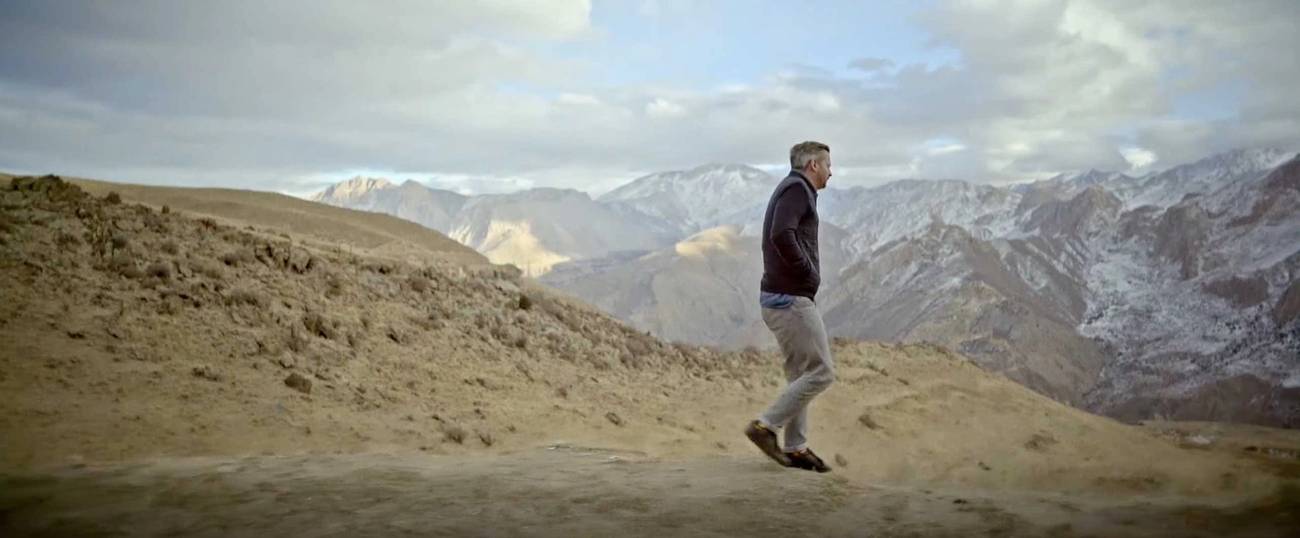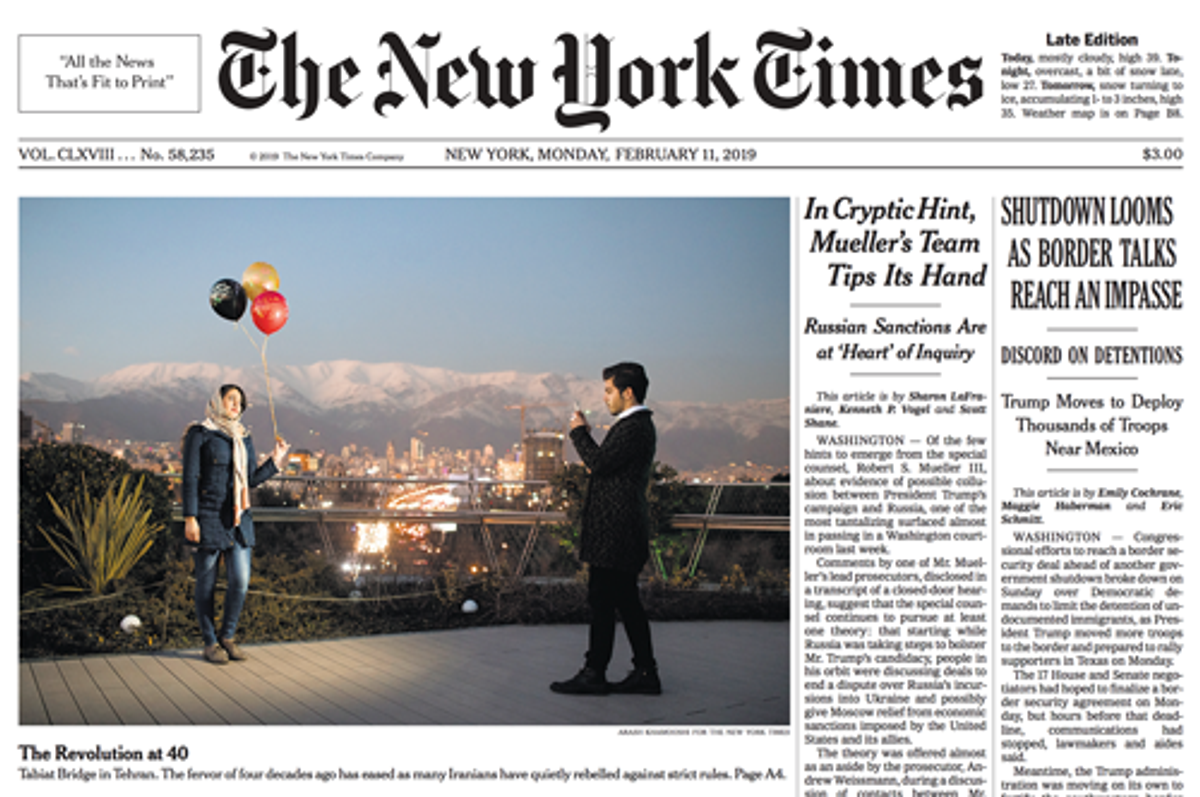What Happened to the New York Times’ Man in Tehran?
The head-scratching case of Thomas Erdbrink, who apparently upset the Iranian government, and went silent for a year




Last month marked one year since the occultation of the New York Times Tehran correspondent, Dutch national Thomas Erdbrink. His last reporting for the Times ran on Feb. 16, 2019. As usual with international mischief involving institutions like the Islamic Republic and the New York Times, the plot is thick, and disturbing.
The Iranian regime is notoriously thin-skinned about how it appears in the global media, and the timing was inauspicious for Erdbrink, who had just published his piece on the 40th anniversary of the Islamic revolution, “From Theocracy to ‘Normality’”—a headline as inaccurate as it might have been welcome to Tehran’s far-from-normal regime. U.S.-Iran sparring over the U.S. withdrawal from the nuclear deal was ratcheting up, with the United States reimposing some sanctions and raising its military profile in the Persian Gulf.
The Times didn’t appear to report the silencing of its correspondent in real time. It was only four months later, on June 10, that the paper reported that the Iranian authorities had barred Erdbrink from working, a report picked up by the Washington Post, whose own Iran correspondent, Jason Rezaian, had been held for 544 days by the regime before being released in a prisoner swap to mark the signing of the nuclear deal. Both papers then dropped the subject entirely, a marked contrast to the customary bluster and hand-wringing over journalists with misfortunes. Reporters Without Borders has never mentioned the Erdbrink case. Nor, by the way, has the Dutch government; the Embassy of the Netherlands in Washington considered my query for about a month before notifying me that this was a consular issue and the responsibility of the Foreign Ministry’s Communications Department to comment upon. (Ultimately the ministry did not comment.) Erdbrink himself also went quiet, and his closest friends and colleagues say they have not heard from him.

The Times, through a spokesperson, confirmed that Erdbrink has been barred from reporting in Iran since early 2019, and added that he will be taking another international post at the paper soon, while noting that their coverage of Iran had not suffered in the interim. The paper had no comment on where Erdbrink had been, or why they haven’t furthered their reporting on his absence.
A reporter who loses his press credentials is no kind of crisis, of course. But the sinister Persian mood music around Erdbrink—and, as we shall see, his employer—is what makes the public absence of the Times’ man in Tehran notable: His last tweet was posted on Feb. 20, 2019, and he has not posted on social media since. Erdbrink surfaced briefly in late January in an interview with the Dutch broadcasting site NOS.nl to lament that he was “the censored man in Tehran” and express the hope that his press credentials would be restored. No U.S. media picked up this story. His Iranian wife, photographer Newsha Tavakolian, was also reported to have lost her press credentials.
The silence of Erdbrink is not an instance of a testy regime slapping a reporter on the wrist. Rather, it is an event somewhere in the murky middle between Iran-held hostages convicted of espionage and whose release is the cause of international campaigns—the American hikers in Kurdistan, Nazanin Zaghari-Ratcliffe and Xiyue Wang—and those whose disappearance remains undisclosed until covert negotiations effect their release, as with U.S. student Matthew Trevithick.
The Times itself has been conspicuously silent about the fate of its marquee Tehran correspondent, who has often been criticized for his whitewashing of the regime. “Officials of Iran’s Foreign Ministry have repeatedly assured the Times that Mr. Erdbrink’s credential would soon be restored but have offered no explanation for the delays or for why it was revoked,” said the New York Times international editor, Michael Slackman, back in June. But has anyone asked the Iranians for an explanation? The Times and U.S. news media broadly have maintained an ethereal level of indifference to any possible unpleasantness. The Israeli and Saudi governments, among others, must be wondering what on earth you have to do to deserve this kind of good manners from American journalists.
Three questions need to be answered. What have the Iranians done to Erdbrink? Why are they doing it? And why the news blackout?
***
To the first question: As a guess, I would say that he was neither imprisoned nor kept under harsh house arrest, but mamnou’-e khorouj, the Persian term for “forbidden to leave,” i.e., silenced and blocked from foreign travel but not confined. (See the harrowing case of The Economist’s Nicolas Pelham.)
“Why” is easy, but it’s long. Erdbrink’s deferential 40-year anniversary coverage of the revolution is not it. A likelier suspect is his Dutch-produced, two-part, four-hour documentary Our Man in Tehran, released in 2018. Part One features scenes from a marriage, some travelogue, Erdbrink being fawned over on camera by Christiane Amanpour and Joe Scarborough, who would later not touch the subject with a 10-foot pole, a colorful mosque-attending fanatic nicknamed “Big Mouth,” and the usual regime talking points about the toppling of Mohammad Mossadegh (who it seems will have the false and indeed hilarious identifier “democratically elected” attached to his name in perpetuity by the guilt-tripping segment of the Western press).
Part Two of the documentary, shot three years later, is worth your time, however, as it was clearly worth the time of the Ministry of Culture and Islamic Guidance. In it, we discover what the Ministry of Information’s media director disliked about Part One: Big Mouth, the noisy, misogynistic “Death to America” fanatic who got too much screen time and made the country appear backward. And that’s only a start. Emboldened by God knows what, Erdbrink proceeds to study the violent crushing of anti-hijab demonstrations and creates an endearing montage of Iranians of all ages being quizzed on which country they’d most like to visit (the USA, by a mile). Then, visiting the USA himself, Erdbrink presents Goorgen, a burly Iranian-American mechanic based in Burbank, California, with a flair for upbeat TV commercials featuring Persian music with automotive lyrics and dancing. Goorgen, who became a folk hero featured on Los Angeles morning shows and even on Ellen, tells Erdbrink all about how much he loves America, and Iran, too. We see the gentle giant photographed with Richard Gere.
The final chapter recounts the arrest and murder in custody of Iranian-Canadian environmentalist Kavous Seyed-Emami in Tehran; the regime’s surveillance of his funeral; the intense societal fears that led to shunning of his widow and two sons; the seizure of their home, their decision to leave Iran for good, and the heartbreaking scene where the sons arrive in Frankfurt to inform a waiting Erdbrink that their mother was seized as she was about to board the plane in Tehran. She begged her sons to go on without her and never to return to Iran, even for her funeral. Her passport was seized, and Erdbrink gets a preview with his own eyes of how Tehran renders you mamnou’-e khorouj.
I lost count of how many Persian buttons were pushed in the less than two hours running time: Ordinary Iranians’ love of country, love of travel, of music, of fun, the craving for respect and national stature, fascination with America, hatred of injustice, and reverence for parents, were documented in living color, thwarted and desecrated, with power that has been notably lacking from Erdbrink’s officially sanctioned reportage for the Times, and must have therefore been doubly or triply intolerable to the Ministry of Information.
No accounting for a “why” in a Tehran intrigue lacks a diplomatic piece, however, and the Erdbrink tale is no exception. On Feb. 20, the same day as Erdbrink’s last tweet, the Islamic Republic had expelled two Dutch diplomats in response to the Netherlands’ expulsion of two Iranian diplomats a few months previous, out of the suspicion of their involvement in the murder of two Iranian dissidents on Dutch soil—Mohammad Reza Kolahi in 2019 and Ahmad Mola Nisi in 2017. With the tit-for-tat expulsions done, and Erdbrink two weeks into his radio silence, the Dutch recalled their ambassador from Iran in early March 2019.
The bad blood between the Netherlands and Iran might have provided a clue to journalists who noticed Erdbrink’s absence, but good luck finding evidence of that in public reporting: The New York Times had a rollicking relationship with the Islamic Republic, having run tours there as part of “Times Journeys,” a luxury travel component of the New York Times Company immortalized by James Kirchick in Foreign Policy in late 2015:
This “once-forbidden land,” as the Times refers to it in its advertising copy for the trip, is now open for business thanks to the nuclear deal—whose passage the journalists on these trips have strenuously advocated. Roger Cohen (who has referred to opposition to the deal as “foolishness dressed up as machismo”) and, in addition to her capacity as an editorial board member, Carol Giacomo (who has characterized Sen. Bob Menendez’s opposition as “pre-endorsement of war”) were prominent supporters of lifting sanctions on Iran in exchange for limits on its nuclear program. It’s impossible to acknowledge their participation in the profit-generating “Tales from Persia” without at least considering the possibility of a serious conflict of interest.
Five years on, the pro-Iran Deal, anti-Trump newspaper of record is in a pickle, because the pro-Iran Deal, anti-Trump regime in Tehran is an awkward target for criticism—and every passing day that Erdbrink is silenced makes it more awkward.
***
A fortuitous change of subject in early 2020 may have temporarily spared the Times some embarrassment.
“Young and old. Rich and poor. Hard-liner and reformer,” we read about an Iran united in defiance against the United States after the killing of arch-terrorist Qassem Soleimani. “General Soleimani … was almost universally admired.” The almost is your only clue that this isn’t Supreme Leader Ali Khamenei talking, but Farnaz Fassihi, Erdbrink’s even more accommodating successor in covering Iran for the New York Times. Even the headline—“Iranians Close Ranks Behind Leaders After U.S. Kills Popular General”—has the chest-thumping tone of Iran’s state-run media. The news is that the U.S. killed Soleimani, but there are at least three elements of propaganda in the headline alone: In fact, the Iranian people are not united against the United States (untrue and certainly not proven), they are not specifically in agreement with their leaders (laughable), and Soleimani was not popular. In the days after his death, Iranian social media abounded with clips of his gigantic portraits being torched, torn down, or pummeled with fists and shoes. Meanwhile, Fassihi was wistfully posting videos of Soleimani reciting poetry.
Fassihi also had an affinity for Iranian Foreign Minister Mohammad Javad Zarif—she co-wrote (with David D. Kirkpatrick) the famous Times profile headlined “He Enjoys American Coffee and Restaurants. Is He a Credible Negotiator for Iran?” The implication is that the terror-supporting cabinet member might be just too darn pro-American. Then again, it’s hard to imagine her reporting taking a different tone, given the paper’s political line on Iran and given the inconvenient fact that the regime is apparently holding her predecessor hostage.
Whatever her motivations, Fassihi’s work on Iran has followed Erdbrink’s pattern of news coverage and local color based on a long history of regional expertise and native-level Persian, and an indefinable something else—let’s call it an enthusiasm to go the extra mile to please her minders, especially on social media. When the first reports emerged in November on Twitter that Tehran’s crackdown on protesters may have resulted in 1,500 fatalities, Fassihi rushed to express her skepticism, without the apparent aid of reporting, alleging that the U.S. State Department was known for inflating figures. Her skepticism of U.S. government sources may be deserved, but the same skepticism is rarely deployed against the Islamic Republic.
Another aspect of this practice is a subtle adoption of Iranian grievance, which also made an appearance in Erdbrink’s tweets from Tehran, where in April 2018 he retweeted a report of the morality police mistreating a woman. The viral video enraged ordinary Iranians, and so, according to the original tweet by Iranian journalist Sobhan Hassanvand: “Interior minister orders report on incident in two days.” By the standards of Western news reporting, at least, the suggestion that a state organ that exists to torment the population is in high dudgeon and will duly investigate its own casual crimes, which are normal, is simply bizarre.
The adoption of official Iranian state grievances—which exist in direct opposition to the grievances of the vast majority of the Iranian people—shined through a February 2019 tweet about President Trump’s support for besieged Iranian demonstrators, in which Trump posted a news photo of a protester braving a tear gas attack. The point of Erdbrink’s tweet was that the photographer who got the dramatic shot, Yalda Moayeri, felt “cheated and abused” that her photograph was posted without her permission. Objectively, the hook here would be a U.S. president upsetting his predecessor’s precedent by openly siding with Iranian protesters—and secondarily a photographer fearing unjust retribution from her government because the leader of the Great Satan liked her photo. Instead, Erdbrink went with a shady if chivalrous deflection to buy Moayeri a little protection.
President Trump copy pastes iconic Iranian protest photo into his tweet, pissing off the photographer who risked so much by taking it. https://t.co/uQb5hOq2g2
— Thomas Erdbrink (@ThomasErdbrink) February 12, 2019
The Iranian diaspora has coined a term for this kind of news management, hashtad-beest, or “80/20,” meaning that 80% of the reporting focuses on the obvious and unavoidable, including mild or implied criticism of the regime, in order to establish credibility among foreign readers. According to Iranian political activist Heshmat Alavi, “The remaining 20 percent of their published material focuses on pushing Iran’s talking points, such as justifying Zarif’s arguments, praising Soleimani as a popular figure and criticizing Iranian opposition groups.” And so the regime-friendly gaslighting produced by the Times’ man in Tehran highlighted a consistent array of topics pleasing to the ayatollahs and irritating to the U.S. administration: the Yemeni humanitarian disaster (always laid on Riyadh’s doorstep, never the Houthis’ or Iran’s), Brett Kavanaugh Bad, anti-refugee attacks in Germany, Israel bombing Hezbollah convoys in Syria (Bad), Saudi Crown Prince Muhammad bin Salman visiting the United States (Bad), Pompeo replacing Tillerson (Bad), John Bolton (Worse), Apple closing its App Store to Islamic Republic consumers (Apocalypse), and predictable logrolling between Erdbrink and Vali Nasr and Al Jazeera’s favorite Iranian-American, Yara Elmjouie.
Erdbrink deserves some credit, however. When NPR interviewed Erdbrink about the then-upcoming Our Man in Tehran release, the interviewer mentioned his longtime residency in Iran with his Iranian wife. Could he be truly objective? “If objectivity is measured by, do I see Iran exactly though a Western view? Then no,” was Erdbrink’s answer. With this artful dodge, he was admitting to being a functional hostage of the regime, and with its array of tools—granting entry visas and press credentials, revoking both at whim, banning, silencing, imprisonment, uniting or separating families, taking hostages—Tehran can dictate not only how it is covered but by whom.
What is striking here to an outsider is the value that Tehran places on intermediaries and proxies. I asked Reuel Marc Gerecht, the Foundation for the Defense of Democracies chief Iran expert, who has traveled through Iran and speaks fluent Persian, about this strategy. “I don’t think the Iranians are as strategic as many folks think,” Gerecht said. “They really are dependent upon Westerners leading on most issues. Most Westerners aren’t being led; if anything, Westerners have the rhetorical lead and Iranians follow. Ben Rhodes, Phil Gordon, Jake Sullivan, to name just a few, don’t need NIAC [National Iranian American Council] to frame arguments. As a rule, Iranian officials are pretty crude and stuck in a left-wing, Islamic, mindset of the 1970s, even if they are young. Zarif only looks good because the others are so bad, so inept with Westerners. The Islamic Republic is like Cuba: it exists in a time warp intellectually. It’s one of many reasons why it can’t evolve and reform.”
Keeping Thomas Erdbrink in limbo probably guarantees a certain level of compliance from his successor Fassihi. Why the New York Times so readily accedes to what looks from here like blackmail is another question. On Feb. 12, 2020, the Washington, D.C., think tank the Atlantic Council convoked a panel titled “Iran: Propaganda and Perception 41 Years After the Revolution,” starring, among others, its own Barbara Slavin, Farnaz Fassihi, and others. In a two-hour discussion about the rigors of reporting from Tehran, Erdbrink’s name did not come up once.
***
You can help support Tablet’s unique brand of Jewish journalism. Click here to donate today.
Peter Theroux is a translator and writer in suburban Los Angeles. After more than 20 years in the U.S. government, he was awarded the Career Intelligence Medal.